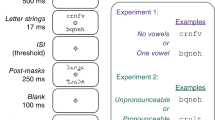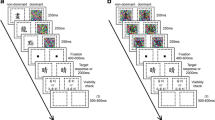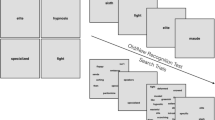Summary
Decisions about the identity of an entire word are made more quickly than decisions about the identity of a letter within a word. Explanations of this whole-word advantage based on the time-course of the activation of different levels of unit detectors have given way to explanations based on how attention is allocated to the output of the detectors. Three studies were carried out to examine the role of attention in the whole-word advantage. In Experiment 1, cues as to the level of decision (whole-word vs. first-letter) facilitated component processing, a finding that suggests word level information is normally the focus of attention. In Experiment 2, identification of a probe item to the right of a display was longer when subjects prepared for a first-letter rather than a whole-word decision. That is, the spatial extent of attention is wider for whole-word decisions. In Experiment 3, probe latencies were longer when subjects prepared for a whole-word decision than when they prepared for a signalled probe trial. Preparation for a whole-word decision is not automatic in the sense of being free of capacity demands. The overall pattern of results leads to the conclusion that the whole-word advantage is an instance of attentional holism.
Similar content being viewed by others
References
Healy, A. F., & Drewnowski, A. (1983). Investigating the boundaries of reading units: Letter detection in misspelled words. Journal of Experimental Psychology: Human Perception and Performance, 9, 413–426.
Henderson, L. (1982). Orthography and word recognition in reading. London: Academic Press.
Johnson, N. F. (1975). On the function of letters in word identification: Some data and a preliminary model. Journal of Verbal Learning and Verbal Behavior, 14, 17–29.
Johnson, N. F. (1986). On the detection of letters within redundant displays. Perception & Psychophysics, 40, 93–100.
Johnson, N. F., Turner-Lygea, M., & Pettegrew, B. S. (1986). Part-whole relationships in the processing of small visual patterns. Memory & Cognition, 14, 5–16.
Jonides, J., & Mack, R. (1984). On the cost and benefit of cost and benefit. Psychological Bulletin, 96, 29–44.
Kahneman, D., & Treisman, A. (1984). Changing views of attention and automaticity. In R. Parasuraman & D. R. Davies (Eds.), Varieties of attention (pp. 29–61). Orlando, FL: Academic Press.
Krueger, L. E. (1978). A theory of perceptual matching. Psychological Review, 85, 278–304.
LaBerge, D. (1976). Perceptual learning and attention. In W. K. Estes (Ed.), Handbook of learning and cognitive processes: Vol. 4: Attention and memory (pp. 237–274). Hillsdale, NJ: Erlbaum.
LaBerge, D. (1983). Spatial extent of attention to letters and words. Journal of Experimental Psychology: Human Perception and Performance, 9, 371–379.
Marcel, A. J. (1983). Conscious and unconscious perception: Experiments on visual masking and word recognition. Cognitive Psychology, 15, 197–237.
Marmurek, H. H. C. (1977). Processing letters in words at different levels. Memory & Cognition, 5, 67–72.
Marmurek, H. H. C. (1986). Whole and part comparisons of words and nonwords. Memory & Cognition, 14, 113–123.
McClelland, J. J., & Mozer, M. C. (1986). Perceptual interactions in two-word displays: Familiarity and similarity effects. Journal of Experimental Psychology: Human Perception and Performance, 12, 18–35.
McClelland, J. J., & Rumelhart, D. E. (1981). An interactive activation model of context effects in letter perception: Part 1. An account of basic findings. Psychological Review, 88, 375–407.
Miller, J. (1981). Global precedence in attention and decision. Journal of Experimental Psychology: Human Perception and Performance, 7, 1161–1174.
Palmer, S. E. (1977). Hierarchical structure in perceptual representation. Cognitive Psychology, 9, 441–474.
Parasuraman, R., & Davles, D. R. (Eds.) (1984). Varieties of attention. Orlando, FL: Academic Press.
Treisman, A., & Souther, J. (1986). Illusory words: The role of attention and of top-down constraints in conjoining letters to form words. Journal of Experimental Psychology: Human Perception and Performance, 12, 3–17.
Tunmer, W. E., & Nesdale, A. R. (1985). Phonemic segmentation skill and beginning reading. Journal of Educational Psychology, 77, 417–427.
Umansky, J. A., & Chambers, S. M. (1980). Letters and words in word identification. Memory & Cognition, 8, 433–446.
Wickens, C. D. (1984). Processing resources in attention. In R. Parasuraman & D. R. Davies (Eds.) Varieties of attention (pp. 63–102). Orlando, FL: Academic Press.
Williams, M. C., & Bologna, N. B. (1986). Perceptual grouping in good and poor readers. Perception & Psychophysics, 38, 367–374.
Yantis, S., & Jonides, J. (1984). Abrupt visual onsets and selective attention: Evidence from visual search. Journal of Experimental Psychology: Human Perception and Performance, 10, 601–621.
Author information
Authors and Affiliations
Rights and permissions
About this article
Cite this article
Marmurek, H.H.C. Attentional holism in visual word processing. Psychol. Res 49, 45–52 (1987). https://doi.org/10.1007/BF00309202
Received:
Issue Date:
DOI: https://doi.org/10.1007/BF00309202




